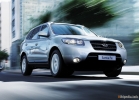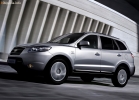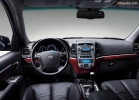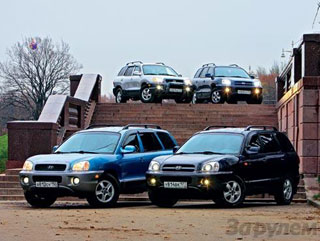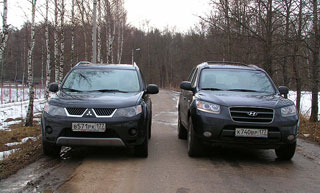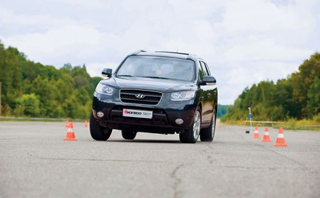Hyundai Santa Fe 2006 test drive - 2009 SUV
Old robbers
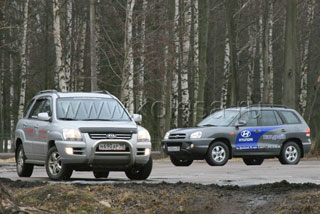 If you find a large-long platform somewhere and roll out on it the crossovers of all world manufacturers, then Hyundai Santa Fe Classic and Kia Sportage will easily be lost at this fair of vanity.
If you find a large-long platform somewhere and roll out on it the crossovers of all world manufacturers, then Hyundai Santa Fe Classic and Kia Sportage will easily be lost at this fair of vanity. These cars are not able to unscrew their heads to onlookers: the appearance is ordinary, and on the go are unremarkable. But the prices for them are quite competitive, which, coupled with a worthy set of consumer qualities, makes these cars a tempting offer.
Leaving with the parking lot on the new Santa Fe Classic, I stop in indecision in front of the curb (this is in a daze; in a pivotal curb) to jump onto the road. The numbers of technical characteristics pop up in the head, but the line of the clearance was hopelessly lost in the corners of memory.
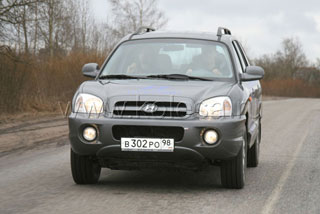 They are insidious, these crossovers: you’ll travel to them for a while, and then for no reason it came to mind the crazy thought to mix dirt somewhere outside the city, or to take advantage of the shortest exit from the parking through such a curb.
They are insidious, these crossovers: you’ll travel to them for a while, and then for no reason it came to mind the crazy thought to mix dirt somewhere outside the city, or to take advantage of the shortest exit from the parking through such a curb. And, an hour is uneven, the capabilities of the car will end much earlier than you want. And the plastic parts of the body kit are how roads
This time it ended safely: 207 mm of the road clearance is the most for such maneuvers. Sportage, which followed, did not disappoint, although its road clearance is smaller: 195 mm.
Not bad, very good! So, maybe you don’t need to be super -moded or very young in order to deliver such little joys and even victories to your owner daily?
These cars are old in the market. Santa Fe appeared in general in 2001; Five years later, the second generation of the model was replaced. Although, in this case, the term is not entirely accurate: the production of the old version migrated to Tagaz was acquired by the Classic prefix and sold in parallel with the new one.
Sportage is somewhat younger than the current generation since 2004. By the way, this model has a twin brother of Hyundai Tucson, but we took the Kia test, because models under this brand are positioned (not by us manufacturers included in one concern) less than than us Hyundai. But is it fair?
Hyundai designers in childhood did not seem to have played enough. Having become adults, they did not lose humor, and a slightly hooligan principle: and we will do in our own way! For them, he remained fundamental.
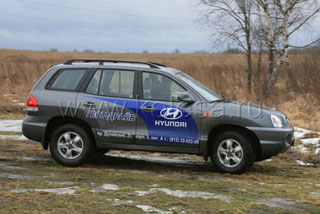 Solid forms, predatory bodies of the body? Not here! Santa Fe looks like a naughty puppy. Its bloated wavy sides do not look defiant, and in the gaze of the lupo -eyed headlights, naive simplicity is read.
Solid forms, predatory bodies of the body? Not here! Santa Fe looks like a naughty puppy. Its bloated wavy sides do not look defiant, and in the gaze of the lupo -eyed headlights, naive simplicity is read. The Kia Sportage standing nearby is much stricter: its body panels are almost even, and only the wheel arches are slightly expanded around the perimeter. From this visually, the car seems much smaller than its opponent, but in reality the difference in size is not so large: the Kia length is 4350 mm against 4500 in Hyundai.
But in general, the design of both machines gravitates to classical forms. There are no fashion trends here, but is the goodness of the car one fashion determined?
Once inside Hyundai Santa Fe, you again seem to plunge into the world of cloudless childhood. You have almost two hundred of forces under the hood and the drive of all four 16-inch alloy wheels, but there are no hints of this at all.
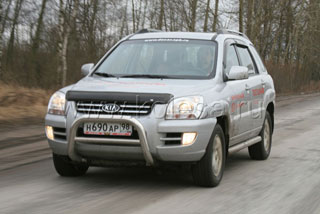 In the endless, almost chaotic world of blowing, curved plastic lines, you feel like in Disneyland. But after half an hour in such an interior, you begin to look for the treasured valve through which this very blowing salon can be slightly lowered.
In the endless, almost chaotic world of blowing, curved plastic lines, you feel like in Disneyland. But after half an hour in such an interior, you begin to look for the treasured valve through which this very blowing salon can be slightly lowered. There are not so many claims for ergonomics. Yes, not the most comfortable chairs without any tangible side support. Yes, a thin steering wheel of large diameter, poorly lying in the palms. Yes, reading the testimony of climate control is convenient only from the rear seat, if you look in the gap between the two front seats, and then lying down
But how good is the review and how much space above your head! And you can get into the car’s interior without thinking which leg should be brought first: you just take and sit down. And you are spacious. And this is important
All this fully applies to Sportage. In the sense, the designers did not regret living space.
But to the design of the salon here is another approach. See deflectors of blowing on a console beard? They are rectangular. And those that are in the corners of the front panel, by the windshield? Those round.
And so in everything round-square topics is completely disclosed (perhaps even too much). And if in the Santa Fe salon you feel like in a children's game room, then the Sportage interior is more like a business office: strict but boring.
Passengers of the second row of seats were satisfied with both cars, but after the procedure for laying out the rear seats, opinions were divided. In Kia Sportage, the operation takes place without venture: you pull the handle on the back and now you have a flat cargo platform.
The Hyundai Santa Fe is getting harder: there you should first remove the headrests, then raise the lower pillow and only then lower the back. But the avid summer residents are already rubbing hands in Santa Fe can be duplicated to a record of 2100 liters of useful volume!
Sportage is more modest: maximum 1411 l. And access to trunk is convenient for both cars or through the door gate, or through the rear window.
On the go, both old men pleased, and not only by the fact that we got the top 2.7-liter versions, although, why deceive? Of course, they pleased! In the city, cars showed themselves the same invigorates: acceleration to 60-70 km/h for them for pleasure.
 A tightly configured suspension that Sportage, that Santa Fe swallowed a good hole, and did not allow the body of the body at all! When we went to the highway, the laws of physicists began to feel sharper: the heavy Hyundai began to be lazy during overtaking, unequivocally hinting that he was comfortable only at the speeds prescribed by traffic rules.
A tightly configured suspension that Sportage, that Santa Fe swallowed a good hole, and did not allow the body of the body at all! When we went to the highway, the laws of physicists began to feel sharper: the heavy Hyundai began to be lazy during overtaking, unequivocally hinting that he was comfortable only at the speeds prescribed by traffic rules. The lighter Kia at high speeds turned out to be more lively, but you need to get used to uninformative and cotton brakes, they added unnecessary adrenaline with sharp maneuvers.
Off -road? Excellent! The colleague said, and we turn off the rural road soaked after rains. In the arsenal of both machines, an automatically connected all -wheel drive and the lack of lowering gears, which, in principle, will allow you to fuck outside the roads within known limits.
In addition, in Sportage, that there is less clearance, there is a blocking of the center differential. In Santa Fe there is no configuration of it in any configuration, so he went to conquer moderate off -road where Sportage will get stuck, Santa Fe will get bogged down and even more so.
On a slippery road, more reminiscent of a cocktail of clay and dirt, Kia moves strained, but ESP (by the way, disconnected) helps confidently when braking). Hyundai is deprived of this system, and therefore walked from side to side with each brake pedal.
What is ahead - a steep descent? Well, let's try the good, both cars have a manual automatic mode that allows you to slow down more efficiently, which is especially important on such slippery slopes. But where the road is crossed by deep pits, we will not sit: the locks of the wheeled differentials are deprived of both cars, and to hang the wheels on crossovers diagonally - the case is a shed: the passages of pendants are small.
 So who are our robbers of the equal to modern crossovers or remnants of the past? Pretty old -fashioned Hyundai Santa Fe Classic is not able to hit the imagination, but rather practical and pleasant in sled disciplines. Another argument for the car is relatively available (especially against the background of competitors).
So who are our robbers of the equal to modern crossovers or remnants of the past? Pretty old -fashioned Hyundai Santa Fe Classic is not able to hit the imagination, but rather practical and pleasant in sled disciplines. Another argument for the car is relatively available (especially against the background of competitors). Kia Sportage is more modern and better equipped exactly on just how much more expensive. But Japanese and American competitors cost even more, and the options offer almost the same way so if we still find the notorious platform, which we were talked about at the beginning, we will lead the elderly old people with the guide. They deserved.
Tests without danger.
Hyundai Santa Fe fought according to the Euro NCAP methodology in 2002. Then he showed, in general, good results, having gained, in total, 4 stars. The car withdrew the side blow perfectly, scoring 16 out of 16 possible points, but the front collision disappeared: the driver’s chest overloads were large. The result is 9 out of 16 points.
Kia Sportage did not go through European trials, but the degree of security of the machine can be judged by the results of the Hyundai Tucson model’s native brother. Machines differ only in decor elements and strokes in appearance.
Tucson was tested in 2006 and earned the same way as Santa Fe 4 stars.
The car with a side blow withstood the car flawlessly 16 points; The frontal clash was slightly worse: 11 out of 16 points. They brought all the same large loads on the driver's chest.
Cars were provided by AvtoMir with an official Hyundai dealer, and Dakar with the official KIA dealer.
Text: Alexander Mikhailov
Photo: Roman Ostanin
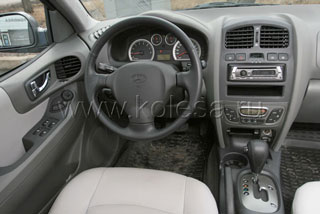
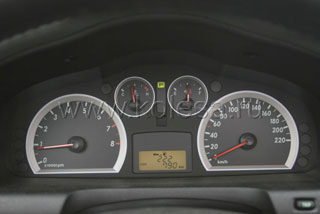

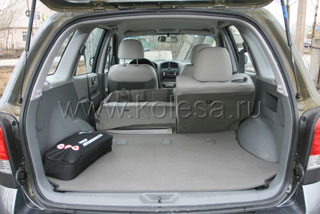
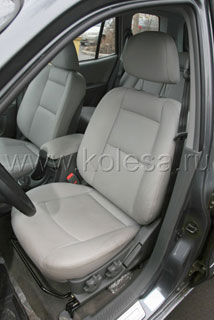



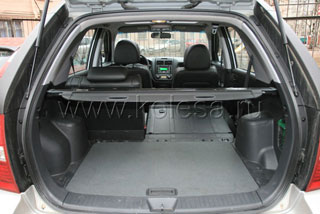
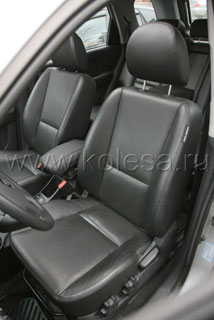
Source: Wheel magazine [March 2008]
Hyundai Santa Fe 2006 Krash Video - 2009
Hyundai Santa Fe 2006 test drives - 2009
Hyundai Santa Fe 2006 Krash Test - 2009
Krassh Test: Detailed Information29%
Driver and passengers
36%
Children-passengers


